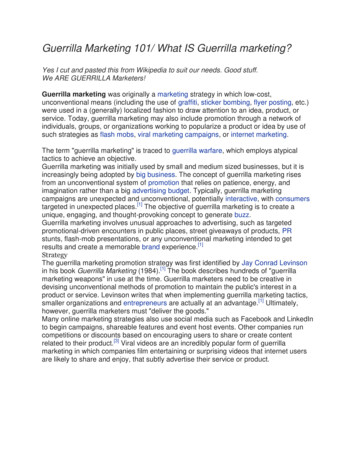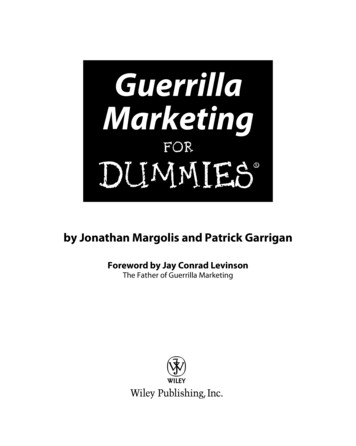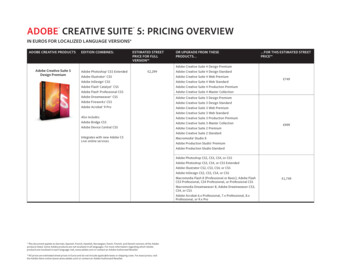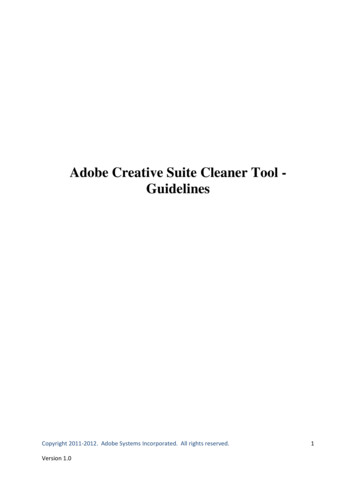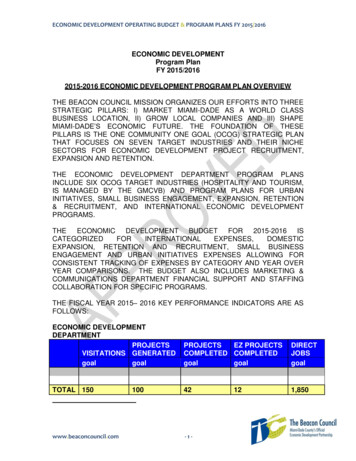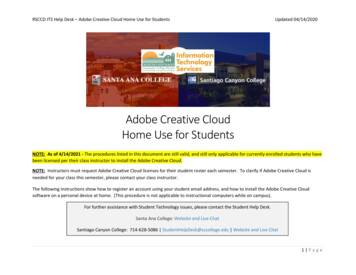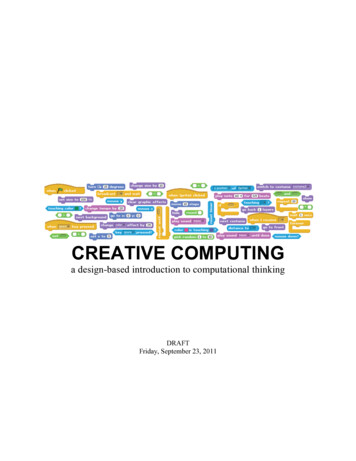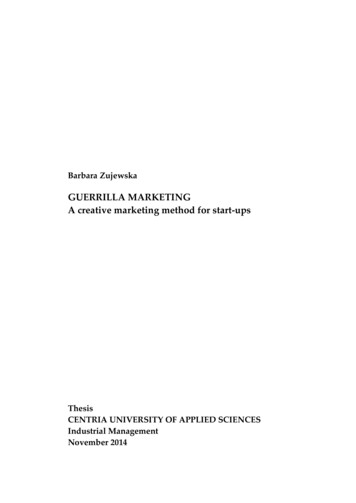
Transcription
Barbara ZujewskaGUERRILLA MARKETINGA creative marketing method for start-upsThesisCENTRIA UNIVERSITY OF APPLIED SCIENCESIndustrial ManagementNovember 2014
ABSTRACTCENTRIA UNIVERSITY OFAPPLIED SCIENCESDateAuthorNovember 2014Barbara ZujewskaDegree programmeDegree programme in Industrial ManagementName of thesisGUERRILLA MARKETING A creative marketing method for start-upsSupervisorPagesMarja-Liisa Kaakko76The objective of this thesis work was to introduce guerrilla marketingas a valuable marketing method for small and medium size startup companies.The thesis presents the theoretical studies on the subject based on literatureand case studies. The practical use of the theory is demonstrated in the marketingplan based on guerrilla marketing approach. The marketing plan was writtenbased on the example of an existing startup company, mCASH. The company islocated in Oslo, Norway.The thesis provides understandable and comprehensive definition of guerrillamarketing and presents the main differences between guerrilla marketingand traditional marketing approach.Key wordsAdvertising, guerrilla marketing, marketing plan.
PREFACEI always underestimated the importance of this part of someone’s thesis. Now,when it is my turn to write it, I finally understand.First of all, I would like to thank my thesis supervisor – Marja-Liisa Kaakko, whowas always there for answering all my questions.Secondly, I would like express my gratitude to my parents – Tomasz Zujewskiand Jolanta Zujewska. Without their constant support I would never get to studyat Centria University of Applied Sciences, not to mention writing my thesisand graduating. Dziękuję!Furthermore, I would like to thank Megan O’Keeffe, because no one else is asgreat a partner for marketing brainstorming and has so much patience for allmy little dramas.At last, but definitely not least, I would like to thank my dear boyfriend, Sietsevan der Molen, who not only survived me struggling with my keyboard, but alsogave me the necessary motivation and was an invaluable help every single day.Thank you all so much!And thank you dear reader, I honestly did not expect you here.
TABLE OF CONTENTS1.INTRODUCTION12.WHAT IS GUERRILLA MARKETING?32.1Historical outline2.2Definition2.3Guerrilla marketing vs. traditional marketing2.4Principles of guerrilla marketing2.5Pros and Cons3. GUERRILLA ADVERTISING TECHNIQUES34599113.1Nontraditional media3.1.1Examples of ambient marketing3.1.2Examples of online marketing3.2Traditional media3.2.1Examples3.3Risks of Guerrilla Advertising4. RELATIONSHIP MARKETING111221272835404.1Customer focus4.2Transactional marketing4.3Word-of-mouth and publicity5. MARKETING PLAN404144455.1Executive Summary5.2Environmental Analysis5.2.1Market Environment5.2.2Competitors5.2.3Market Segmentation5.3Business Analysis5.3.1Product Overview5.3.2SWOT Analysis5.4Marketing Objectives5.5Marketing Strategy5.5.1Target Market5.5.2Marketing Mix5.6Marketing Implementation5.7Evaluation6. S72
FIGURESFIGURE 1. “Try K2r” by K2r; Paris, France14FIGURE 2. “Wrong Faith and Wrong Opinion” by Amnesty International;Frankfurt, Germany15FIGURE 3. “Forever sport” by Adidas; Singapore15FIGURE 4. “10X Optical Zoom” by Olympus; Sydney, Australia16FIGURE 5. “WE DO IT” by reversegraffiti.co.uk17FIGURE 6. Clean graffiti by ARIEL17FIGURE 7. Car dirt art by JORDAN car wash18FIGURE 8. “Welcome Back” by T-mobile; London, UK20FIGURE 9. “Worst Breath in the World” by TicTac; Paris, France20FIGURE 10. “Dumb ways to die” by Melbourne Metro26FIGURE 11. “Snakes On A Cane” by Fox TV; USA; stage one30FIGURE 12. “Snakes On A Cane” by Fox TV; USA; stage two30FIGURE 13. “Snakes On A Cane” by Fox TV; USA; webpage31FIGURE 14. “Snakes On A Cane” by Fox TV; USA; stage three32FIGURE 15. “EmployAdam” by Adam Pacitti; London, UK33FIGURE 16. “Please don’t speed near schools” by EnvinromentWaikato;Waikato, New Zeland34FIGURE 17. “36.6” by Plus GSM; Poland36FIGURE 18. “It’s better with the Butterfly” by Microsoft; New York, USA37FIGURE 19. “Aqua Teen Hunger Force” by Turner Broadcasting Systems;Boston, USA38FIGURE 20. P-to-P advertisement67GRAPHSGRAPH 1. Internet penetration in Europe, data from 201422GRAPH 2. Social media users in Europe, data from 201423GRAPH 3. mCASH target markets47GRAPH 4. Number of point-of-sale terminal and ATMs per thousandof inhabitants, data from 2001-201248
GRAPH 5. Population of Norway by age, gender and marital status,data from 201349GRAPH 6. Smartphone penetration in Norway, data from 2011-201349GRAPH 7. Smartphone penetration in Norway by age group and gender,data from 201350GRAPH 8. Growing markets, data from 2012-201350GRAPH 9. Online transactions per customer in Norway, data from 2010-201351GRAPH 10. Use of smartphones for purchasing, data from 2012-201351GRAPH 11. Mobile shopping by age group, data from 2012-201352GRAPH 12. Cash as a share of a means of payments in selected countries,data from 201252GRAPH 13. Online payment methods in Norway, data from 201353GRAPH 14. The reasons for the choice of the online payment method, data from 201354GRAPH 15. The mCASH environment58
11. INTRODUCTIONEvery company, regardless of its area of business, provided services or location,needs marketing. For decades, the importance of marketing has continuouslyincreased. Its definition and role has evolved in response to the changingeconomic environment. Today, a product or service provided by a business mustbe known by the potential buyer to make the business successful. The only wayto successfully achieve this is to pursue creative and consistent marketingstrategies.However, in the era of emerging technologies, social media, and globalization,marketing is changing more rapidly than ever before. Increasing competitivenessand the fragmentation of most markets makes modern marketing processcomplicated and difficult to follow. Independent entrepreneurs and the ownersof small and medium sized businesses struggle with understanding marketingand finding the right strategy to effectively utilize their limited resources. In hisseries of books, American business writer J.C. Levinson purposes guerrillamarketing as an answer to the marketing needs of SME and NGO (Levinson 2005,10.).The first chapter of this thesis defines the concept of guerrilla marketing. Fromunderstanding traditional marketing and its historical outline, the reader canrecognize the need for a new marketing strategy. This presents guerrilla marketingand its differentiating features from traditional media marketing, along with bothits advantages and disadvantages.The second chapter provides information about traditional and nontraditionalmedia vehicles, also with their advantages and disadvantages. It will also touch
atelyillustratethe provided theoretical information and inspire creative use of available media.Possible threats that carelessly planned or executed campaigns may incur are alsoexplored.The third chapter explains the basis of relationship marketing, and the Descriptiveexamplesprovethe importance of relationship marketing and its potential value for businesses.The last chapter focuses on the practical use of a guerrilla marketing strategy fora startup company, mCASH. Based in Oslo, mCASH is the first Norwegianprovider of a mobile payment system. Their product was launched in February2014. The objective of their marketing campaigns is to prove its value to potentialand current investors. The proposed strategy is a combination of traditionalmethods of marketing and guerrilla marketing.
32. WHAT IS GUERRILLA MARKETING?Marketers around the world define guerrilla marketing in a variety of ways. Somesources say that it is only an advertising method, while others state it includesmany more aspects. These differences are inevitable. Even the term ‘marketing’ isa broad idea that does not have one ultimate and fully clarified definition.There is no agreement on a definition of marketing. A shelf-fullof textbooks on the subject produces a shelf full of differences.(Tedlow & Jones 1993, 150.)2.1 Historical outlineThe history of marketing and its development is indivisibly connected withthe history of the market; changes in the market generated a need for marketing.In principle, the shared history of the market and marketing can be divided intothree stages:I. Fragmentation (until the second half of the XIX century) – In this phase,the market was highly fragmented. Transportation of goods was expensive,production was mainly low volume, and products were sold locally and usuallyhad a high margin because of a low-level of competition. At this stage, the needfor marketing was low or non-existent. (Tedlow & Jones 1993, 8-35.)II. Unification (the second half of the XIX century through the middle of the XXcentury) – The implementation of mass production and the lowering cost of transitcaused a both decrease in the margin level and a rapid growth of competition.In the second phase, companies were faced with a growing need for marketingtheir products in order to stay on the market. (Tedlow & Jones 1993, 8-35.)
4III. Segmentation (from the middle of the XX century) – At this stage, the worldmarket became segmented in both a demographic and psychographic sense.In addition to a pricing strategy, the right type of advertising became crucial.(Tedlow & Jones 1993, 8-35.)The cultural, economical and in particular technological developments in the XXIcentury drastically deepened the segmentation. The availability of new media,the change of habits in the younger generation and the higher level of customerawareness makes it increasingly difficult to reach the target audience. Facingthose difficulties and meeting the marketing needs of SME makes new marketingstrategies arise. (Tedlow & Jones 1993, 8-35.)2.2 DefinitionThe English word ‘guerrilla’ comes from the Spanish diminutive of ‘war’and therefore its literal meaning is the ‘little war’. In English, the word means‘a fighter in an irregular, independent armed force’ and as such perfectly describesthe nature of the guerrilla marketing. (Skeat 2007, 225.)For the purpose of this report, the author focused on the definition of guerrillamarketing created by Jay Conrad Levinson, also known as the father of guerrillamarketing. Levinson was the very first person to use this term, and describes it inhis book “Guerrilla advertising”, published by Houghton Mifflin in 1984. Sincethen Levinson published over 25 books on the subject. Guerilla marketing hasevolved over the years because of the changes in the world market, customersand technology. The main idea, however, remains unchanged and can bepresented as:
5Guerrilla marketing is unconventional strategies, secrets, and tacticsfor earning conventional goals - big profits from your small business.(Levinson 2005, 5.)Guerrilla marketing focuses on reaching the target audience in an originaland surprising way with low- or even no-cost and therefore maximizing returnon investment rate. It is a great opportunity for small companies, since guerrillatechniques usually require more time and creativity than actual resources. Thanksto the use of word-of-mouth and social media successful guerrilla action caneffectively reach the target market (often a niche market), but also establish brandrecognizability. Very often advertisements are interactive and usually exploitnontraditional media. (Levinson 2005, 3-35.)As mentioned before, marketers do not agree fully where to draw the bordersof guerilla marketing. One of the main examples is the usage of marketingstrategies based on the guerrilla approach by big companies. Of course in that caseone of the main assumptions, low cost, is usually omitted and guerrilla marketingoften plays only a supporting role for a traditional advertising campaign.2.3 Guerrilla marketing vs. traditional marketingThere are several differences between guerrilla marketing and traditionalmarketing approach. Understanding those differences is crucial to understandingguerrilla marketing.One of the main differences is the engagement of resources. In the traditionalapproach, the key requirement is money whereas in the guerrilla approach time,effort, creativity and knowledge are much more important. This enables smallcompanies to compete with bigger businesses. This naturally leads to anotherdifference – guerrilla is designed for SMEs whereas traditional marketing
6intended for big companies. However, as mentioned before, big companies arealso the exploring possibilities of new marketing strategies. (Levinson 2005, 6-9)Guerrilla marketing is relatively easy to implement. Most of Jay ConradLevinson’s books are addressed to business owners and not to marketingprofessionals. The idea is to free marketing from its mystical and intimidatingappearance, giving control of all marketing process over to the entrepreneur.(Levinson 2005, 6-9)Every process of the company is measured and special key indicators show howsuccessful a particular move was. The same goes for marketing, where the keyperformance indicators show if an advertising campaign or pricing policy wentwell. In the traditional approach the success of marketing is usually measured byan increase or decrease in sales, while guerrilla marketers search for a shift inthe profits rate instead. (Levinson 2005, 6-9)Traditional marketing is generally based on professional expertise, namelythe experience of the marketing team and their judgment, while guerrillamarketers base their decisions mainly on psychology and human nature.(Levinson 2005, 6-9)In addition, the way in which traditional and guerrilla marketing grow varies.Traditional marketing aims to grow the business in a rather linear pattern and ina second stage diversify it. Its marketing actions are more expensive sinceit focuses on growing the customer base alone. The number of purchasetransactions increase, but not necessarily their value. At the same time, guerrillamarketing concentrates on the continuous growth of the market shareand the progress is geometrical. The key issue in that matter is the performanceindicator – guerrilla marketers search for a higher profit, not a larger customer
7base. The way to achieve this objective is to convince existing customers to buymore, more frequently and utilize their positive feedback to gain more customers.(Levinson 2005, 6-9; Margolis & Garrigan 2008, 58.)Crucial for guerrilla marketing companies is to follow up and maintaina constructive relation with their clients. Most businesses using traditionalstrategies neglect this issue. About 68% of businesses in the United States ignoretheir customers after a purchase is made (Levinson 2014). Well plannedand executed post-purchase marketing is a major contribution in reaching thegoals presented in the previous paragraph. Moreover, it helps in establishinga long term personal connection with the client and plays a significant rolein gaining customer loyalty. (Levinson 2005, 6-9; Margolis & Garrigan 2008, competitors.While the traditional approach seeks for a way to undermine and obliteratethe rivals, guerrilla marketers see them as potential partners. Finding andexploring relations can be an asset to any company. Naturally this attitude appliesbest to companies that produce or deliver services that are compatible with theirproduct, but guerrilla marketing proves that even the biggest competitors canbenefit from cooperation. (Levinson 2005, 6-9)Traditional companies make sure that the customer knows the company, its nameand products. The company is what matters. Guerrilla companies are headingto the opposite direction. Guerrilla companies are personalized, which meansthat the owner or the person who leads the company is the advertized ‘object’.The company’s brand is important, but it is the people working at the companywho create it. The company’s owner is its brand, to the same extentas the company’s name. (Levinson 2005, 6-9)
8There is a significant difference in attitude towards the customer in traditionaland in guerrilla marketing thinking. The former focuses on what the customer cangive to a company – “how much can he spend? How much money can we earn?”The latter rather asks “what can a company give to the customer?”. All furtheradvertising and marketing strategies are based on that thinking. (Levinson 2005, 69)In the traditional approach the emphasis is placed on advertising, whilein guerrilla marketing the advertising always goes together with other waysof catching the customer’s attention. Crucial is the usage of nontraditional mediaand interaction with customers. Traditional marketing can be comparedto a monologue, where the communication is one way whereas guerrillamarketing tends to be an open dialogue. (Levinson 2005, 6-9)Guerrilla marketing embraces the use of technology. It is the main communicationtool utilized and can be extremely useful in advertising, especially when reachinga younger audience. Traditional marketing relies heavily on proven lebrityendorsement,etc.This is another distinctive feature of traditional marketing. The usage of primarymedia is rather impersonal and aimed at larger groups while guerrilla marketingtries to use different tools to send a personal message to the specific target group.Advertisements are one example of those tools. Every single aspect of customerrelation and brand perception can be considered as tool as well. As a result,guerrilla marketing gives entrepreneurs multiple effective and money saving toolsthat can be prepared and managed by a business owner. (Levinson 2005, 6-9;Margolis & Garrigan 2008, 58.)
92.4 Principles of guerrilla marketingAll principles of guerrilla marketing have been mentioned in the previous sectionsof this report. However, an understanding of the basic assumption is crucial,therefore they are clearly listed below: Has a basis in human psychology and the way people think and react. The emphasis is placed on profit. An important measurement is the number of created relationships withina period of time. Aimed at the target market and audience. Three ways of growing a business – new referrals, increase in the numberof transactions per customer, increase in the value of transactions. Support for cooperation with other companies. Building a marketing program with multiple elements that are supportingeach other. Technology is one of the most important tools.(Levinson & Lautenslager 2009.)2.5 Pros and ConsJust as any other marketing strategy, guerrilla marketing has its pros and cons.It may be hard to identify them, depending on particular circumstances.Pros:COST EFFECTIVENESS – the creative use of low-cost or no-cost methodsof marketing aims for the most effective use of the company’s budget.MEMORABLE – one of the most important features of guerrilla marketing isto make the marketing action stick out and therefore be unforgettable.
10WORD-OF-MOUTH – memorable campaigns are naturally a conversationalsubject, which is one of the guerrilla business goals.(Blakeman 2014, 37-56)Cons:PUBLIC OPINION – guerrilla marketing campaigns are often controversialand therefore businesses using them should always consider the risks.TIME INVESTMENT – in order to make up for the lack of budget or variousresources guerrilla marketing often require remarkable time sacrifices.CREATIVE SKILLS – certainly not every business owner’s strength is creativity,which is a major obstacle in creating a successful guerrilla campaign that relieson out-of-the-box thinking.(Blakeman 2014, 37-56.)
113. GUERRILLA ADVERTISING TECHNIQUESNowadays, the accumulation of commercial messages on television, radioand the street’s billboards is overwhelming. Viewers no longer rely on thosemessages and often ignore them completely. Marketers need to find new waysof sending their message, a way that enables them to bypass the clutter of massmedia and send a more personal message to potential customers. Not a completesentence (Blakeman 2014, 85-86.)3.1 Nontraditional mediaFinding a clear definition of nontraditional media is not easy. The explanationof the term changes with time. As a result of technological advancesand sociological changes, media vehicles are evolving, often much faster thanthe marketers’ perception of them. Possibly the most accurate definitionof nontraditional media is that it tends to enter people’s lives in an unexpectedand original way. (Blakeman 2014, 85-100.)For guerrilla marketers, nontraditional media vehicles are the core interest.The reason for that is, among others, the possibility of sending a more directmessage to the niche market, but also the fact that those vehicles allow minimizingthe cost while maximizing the effects. Below there is a list of the most importantpros and cons of nontraditional media. (Blakeman 2014, 85-100.)Pros:CONSUMER FOCUS – every business should primarily focus on the customer’sneeds, regardless if they are creating a product/service or a marketing campaign.
12CREATIVE – by definition the output of a creative process’ output is alwayssomething new, something unknown that attracts people’s attention, and those arethe attributes of every successful marketing campaign.TARGETABILITY – unlike traditional mass media vehicles nontraditional mediacan be targeted at much smaller niche markets.INTERACTIVE – creativity and original features make nontraditional marketingmore memorable and effective leveraging personal engagement of potentialcustomers.AFFORDABLE – thanks to use of low-cost methods and creativity, the budgetrequirements are often much lower than when using traditional media.(Blakeman 2014, 94.)Cons:REACH – depending on the particular type of nontraditional media used itmay be relatively difficult to reach the whole target market. It is often boundto the particular location where the campaign takes place.TIME – the process of preparing the nontraditional media campaign is often llyconsideringwhat is the transience of the commercial.ROI – it is relatively difficult to estimate the return on investment for campaignsutilizing nontraditional media.TRANSIENCE – nontraditional ads not only last for a very limited time, but alsoare impossible to repeat and reach a similar result in the same time.(Blakeman 2014, 94.)3.1.1 Examples of ambient marketingWhile discussing nontraditional media there are a few key terms that cannot beoverlooked:
13Ambient marketing – this term is used to describe almost every formof nonstandard marketing. Often the main advantage of ambient marketingis the placement of the advertisement, therefore it is often referred to as placebased advertizing. To a great extent, it is synonymous with nontraditional media.(Derval 2007, 32.)Outdoor, indoor and street marketing – those terms determine onlythe positioning of the advertizing efforts, not the method used.Ambush marketing – this term is much more precise than the ones previouslydescribed. It is a form of marketing where the advertiser associates its image witha particular event, but without paying the sponsor fee. (Louw 2012, 93.)Buzz marketing – this is a general term for any event or activity that generatespublicity, excitement or information to the customer which is known as buzz.Essentially, well done buzz marketing creates public attention that can be usedas a PR vehicle. (Hughes 2008, 1-9.)During the last decade a growing number of small and big businesses, NGOsand individuals have used nontraditional media in their marketing strategy.Some managed to achieve astonishing results.Try K2rThe “Try K2r” campaign aimed to promote the usage of the stain remover K2rin France. The marketers used stains of oil commonly present in streetsand parking areas. By simply painting an outline of a piece of clothing aroundthe stain they drew attention to their advertisement and presented the qualityof their product (see FIGURE 1). This campaign is a perfect example of howimportant creativity and placement of the marketing message are. (Gavin Lucas2006, 26-27.)
14FIGURE 1. “Try K2r” by K2r; Paris, France (addapted from Gavin Lucas 2006, 2627.)Wrong Color, Wrong Opinion, Wrong FaithAmnesty International is a well-known international nonprofit organization.During the past years this NGO has successfully drawn attention to its cause withclever guerrilla advertizing. Wrong Color, Wrong Opinion, Wrong Faith is a greatexample of their marketing efforts. It has been carried on on the main crossroadsin Frankfurt, Germany. The idea was to catch the attention of passers-by witha shocking view of what appeared to be a man trapped in a drain (see FIGURE 2).When the viewer came closer he discovered that it is indeed an amnestyinternational’s installation. The campaign brought a powerful message – one doesnot want to pass by an unjustly imprisoned man no matter what is his opinion,faith or skin color. This campaign on the spot encouraged over 800 people to joinan action against human right violation around the world. (Gavin Lucas 2006, 3637.)
15FIGURE 2. “Wrong Faith and Wrong Opinion” by Amnesty International;Frankfurt, Germany (adapted from Gavin Lucas 2006, 36-37.)Forever sportThis marketing campaign was aimed to promote exercising by pointing outto people that sport is present everywhere. With Adidas logo stickers, marketersrevealed objects in public space that were similar to sporting equipment (seeFIGURE 3). It was a simple shift of perspective. For example, dangling ringsin a public bus touted their resemblance to gymnastics rings. It is a perfectexample of the clever usage of everyday objects. (Gavin Lucas 2006, 58-59.)FIGURE 3. “Forever sport” by Adidas; Singapore (adapted from Gavin Lucas2006, 58-59.)
1610X Optical ZoomIn 2004 Olympus released its newest camera with a 10x optical zoom. In orderto promote it the company prepared quite an unusual marketing campaign.Extraordinarily large objects appeared on Australian streets (see FIGURE 4).Leaves, bicycle locks, cats were exactly 10 times bigger, just as big as their normalsize equivalent could be in the eye of newest Olympus’ camera. The ads not onlyshowed off this feature of the product unique for its time, but certainly caughtattention of everyone around. (Gavin Lucas 2006, 66-67.)FIGURE 4. “10X Optical Zoom” by Olympus; Sydney, Australia (adapted fromGavin Lucas 2006, 66-67.)Clean/Reverse GraffitiAmong the many artistic forms of expression that can be seen on the streets, oneof the more interesting styles is the so-called clean or reverse graffiti. It can beused by virtually anyone. In principle the technique requires only an idea,a template, a pressure cleaner and a little time. The template patterns are“applied” through the purification of the display surface – be it the pavementor a brick wall (see FIGURE 5 and 6). Graffiti as a form of expression, no matterif for commercial use or not, has always been a controversial topic. The main issue
17is of course the devastation of buildings. In the case of clean graffiti, this problemis minimized, after all the graffiti cleans the surface rather than covering it.FIGURE 5. “WE DO IT” by reversegraffiti.co.uk (adapted from Reverse GraffitiAdvertising 2014.)FIGURE 6. Clean graffiti by ARIEL (adapted from Contaldo 2005.)A very clever version of the clean graffiti idea is the so-called car dirt art.This form of art, preformed by using the dust on car’s windows was most likelystarted with simple “Wash your car!” message left by a passerby. Lately this hastruly evolved to an art form. Clever marketers did not miss this opportunity
18as a form of expression either. FIGURE 7 shows possibly the simplest and yetcreative guerrilla marketing example – using a dirty car for advertizing a carwash. Not only does it reach exactly the right recipients, but it also does so withnegligible material cost.FIGURE 7. Car dirt art by JORDAN car wash (adapted from Orangemaster 2008.)Flash mobAnother example of nontraditional marketing is a technique known as Flash mob.It has been a very popular means of sharing virtually any message, from nonprofit causes to more commercial messages. The first Flash mob took placein Manhattan in May 2003. The idea behind it was simple – confuse as manypeople as possible, there was no greater message to send. However, the creator,Bill Wasik – a senior editor of Harper’s Magazine, proved existence of extremelyeffective mechanism of gathering and connecting people. Namely, he managedto convince a large group of people to join the event and he managed to do sosolely via email without revealing his identity. Later on Flash mobs gainedpopularity all around the world and have since been adapted as a marketingtechnique. (Heaney 2005.)
19However, the commercialization of Flash mobs has decreased their influenceon people’s imagination. In the late 2000’s Flash mobs have stopped being a cheapand interesting way of catching people’s attention and become a highly organizedand often extremely expensive marketing event. The case of Flash mob shows howshort a life-span nontraditional media vehicle may have in a context of guerrillamarketing. (Lum 2010.)Despite the general aversion to commercialized, high-budget Flash mobs therehave been many that successfully caught people’s attention and gone viral.The most common ones are the dancing Flash mobs; two good examples arethe Flash mob organized by T-Mobile in Liverpool (July 2009) (Lum 2010.)and a non-profit tribute to Michael Jackson that took place in many citiesworldwide such as Stockholm in July 2009 (BouncE Streetdance Co::. 2009).Another great example is a Heathrow Airport Flash mob by T-Mobile fromOctober 2010, where incoming passengers were greeted by musical actors singingsituational appropriate songs (FIGURE 8). A perhaps slightly contro
Guerrilla marketing is unconventional strategies, secrets, and tactics for earning conventional goals - big profits from your small business. (Levinson 2005, 5.) Guerrilla marketing focuses on reaching the target audience in an original and surprising way with low- or even no
